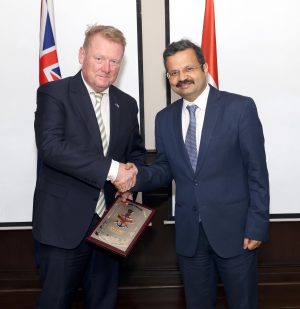A fortnight after the Indian and Australian cricket teams battled each other on the cricket pitch, the sports rivalry receded into the background as defense officials from New Delhi and Canberra discussed ways of deepening their already close cooperation for tackling a resurgent Chinese military in the Indo-Pacific.
The discussions at the ninth edition of the India-Australia Defense Policy Talks, which was held in New Delhi on March 17, centered on maritime domain awareness, reciprocal information sharing, and industry and science and technology collaboration. “India and Australia are committed to working together to promote a peaceful, stable, and prosperous Indo-Pacific region,” New Delhi stated in a media release. The two sides agreed on priorities and preparations for the next Foreign and Defense Ministerial Dialogue (“2+2” talks) to be held in Australia in 2025.
The recent talks followed on from the eighth edition, held in 2023, and the outcomes of the second 2+2 talks held in November 2023.
With the rise of China, defense cooperation has emerged as an important pillar of the India-Australia Comprehensive Strategic Partnership. In New Delhi, both India and Australia welcomed the sustained progress in bilateral defense cooperation, especially the growing frequency and complexity of defense exercises and exchanges.
In August 2022, India’s military participated in Exercise Pitch Black, a biennial, multinational exercise hosted by the Royal Australian Air Force (RAAF) in Darwin, Australia. That saw the participation of over 100 aircraft and 2,500 military personnel from various air forces, undertaking multidomain air combat missions in a complex air environment. The Indian Air Force participated with over 100 troops, four Sukhoi-30 MKI fighters, and two C-17 Globemaster III aircraft.
The two militaries have trained together for years in Exercise Malabar, the ever-more sophisticated quadrilateral navy exercise that also features the U.S. and Japan. The successful conduct of Exercise Malabar in 2022 illustrated how the rise of an aggressive China in the western Pacific is bringing together New Delhi and Canberra in a shared commonality of interests.
In addition to Exercise Malabar and Exercise Pitch Black, the two militaries also participate jointly in the bilateral Exercise Austra Hind and Exercise Ausindex.
Aiming to maintain pressure on Beijing, Washington moved purposefully in September 2021 to persuade its two most steadfast allies — Australia and the United Kingdom (U.K.) — to join it in the so-called AUKUS grouping. AUKUS quickly announced its support for Australia to acquire a nuclear-propelled, conventionally armed submarine fleet. AUKUS has two pillars: Pillar 1 involves transferring nuclear submarine propulsion technology (without nuclear weaponry) to Australia, and Pillar 2 focuses on cooperation in eight military, high-technology areas: the domains of artificial intelligence, quantum technologies, innovation, information sharing, and cyber, undersea, hypersonic and counter-hypersonic, and electronic warfare.
Signaling its intention to operate closely, AUKUS announced that by the end of 2004, its three constituent nations would field a new “trilateral algorithm” that would allow them to share information from P-8 Poseidon sonobuoys — the first tangible AUKUS Pillar 2 technology to hit the field. This new algorithm would allow AUKUS partners to access and process intelligence data from each other’s sonobuoys.
A key AUKUS mission is to track Chinese submarines in the Indo-Pacific using the Boeing-manufactured P-8 Poseidon maritime surveillance aircraft, which is widely regarded as the world’s most capable and networked submarine hunter. The U.S. operates 120 P-8 Poseidons, Australia 12, and the U.K. nine. Sonobuoy information is highly sensitive, even among Five Eyes partners (AUKUS countries + Canada + New Zealand).
Although the Indian Navy operates 12 P-8 Poseidon aircraft, it is not a member of AUKUS, which remains an arrangement among the closest U.S. allies. The U.S. has never offered its nuclear submarine technology to any other ally or partner country, including India. Washington’s break with this strategic tradition to share such technology with Australia suggests that it considers the latter’s support essential in the event of another Taiwan crisis.
Apparently, the U.S. military does not regard India as an essential part of those arrangements. Australia regards itself as the United States’ most reliable Asian ally, given that they have fought together in every U.S. war since World War 1. Australia’s link with the U.S. has been central to the former’s long-term security. Washington would assume that, in the manner of military allies, the Australians and the British would fight alongside U.S. forces in any future wars. That requires Australia’s military to be equipped with enough high-tech forces and equipment to allow them to punch above their weight.
Discussions between India and Australia also called for collaboration between their industries in the fields of defense science and technology. They agreed to deepen cooperation and interoperability across maritime, land and air domains, including working with multilateral partners.
New Delhi and Canberra are also in advanced discussions about cooperation in hydrography and air-to-air refueling. In a bilateral meeting with Australian Defense Minister Richard Marles in New Delhi last November, India’s Defense Minister Rajnath Singh also proposed, that the Australian and Indian militaries should cooperate in niche areas like artificial intelligence, anti-submarine and anti-drone warfare, joint research in underwater technologies, and the cyber domain.
The Australian and Indian defense ministers also agreed in New Delhi that deepening cooperation in defense research would give a fillip to the already strong relationship. The two ministers discussed collaboration between the defense start-ups of both countries, including the solving of defense industry challenges jointly.
There is growing satisfaction in the Australian and Indian capitals over the military-to-military cooperation, which augurs well not just for the mutual benefit of the two countries but also for the overall security of the Indo-Pacific. Now, with the two countries’ defense industries and their science and technological establishments cooperating in the development of defense equipment, a formidable security axis is taking shape in the Indo-Pacific.

































